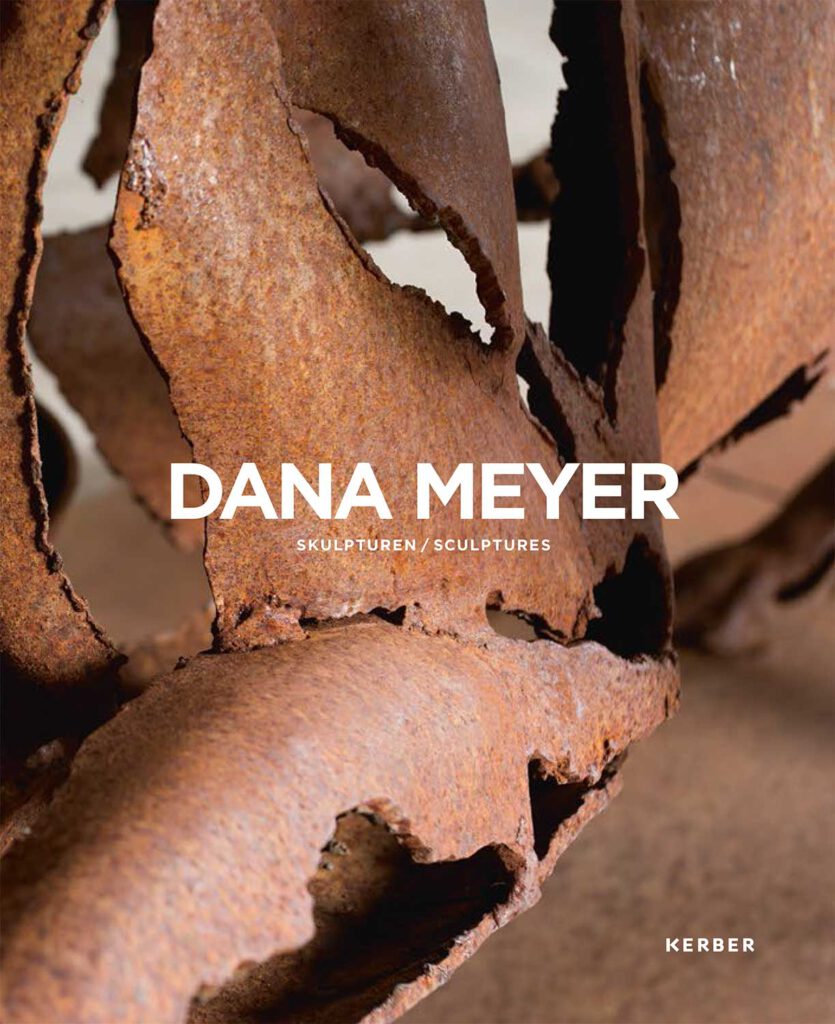Dana Meyer’s sculptures are characterized by high tension, powerful dynamics and anatomical precision. They depict animals and people, individually, in groups, or occasionally in fragments. Meyer’s works are realistic and expressive, haunting in their expression, sometimes seeming metaphorical, sometimes portrait-like.
Dana Meyer forges her sculptures freehand from steel. She refrains from making initial design models. This virtuoso method requires a high level of craftsmanship in addition to extraordinary spatial imagination.
Dana Meyer recognizes a “physical affinity” between human and animal figures, that dissolves the
boundaries of the animal kingdom. The artist writes: “In allegories and metaphors people recognize
themselves as animals with their idiosyncrasies, characteristics and archetypes. The interplay and
simultaneity of experiences in these visual worlds is more direct. In this way the figure refers to something felt and an individual reminiscence, and thus there is something familiar in the character it depicts.”
The artist welds individual forged pieces into figures. She attaches just as much importance to the spaces in between and the hollow areas as to the steel parts. Altogether they form the sculpture and its perceptible force field.
Dana Meyer already effectively uses the principle of the invisible force field in her first large composition, the “Ice-Skater”, which she created in 2011 as her diploma thesis: an almost life-size group, representing a man and four dog figures, pulling an invisible load, probably a sledge. Although not pictorially present, the vehicle is the logical anchor point of the entire composition.
In this early group of sculptures, Dana Meyer already expresses a far-reaching ideological position. She withdraws the protagonist’s role from the human being, whom she depicts without a face, and places him on the same level as the draught animals. She designs a new hierarchy in which Homo Sapiens relinquishes his place at the top.
In 2013, the artist conveys the act of renouncing the “crown of creation” with the figure “The rebellious Aaron”. Aaron exchanges his head for a bull’s head. He distances himself, as it were, from his human nature and performs an act of merging with the animal nature. The group “Pigs”, completed in 2013, presents the same idea from the other end. The animals in the herd prove to be curious individuals with humanlike preferences and vices.
The artist postulates an even more radical statement in the “Fox Hunt”, completed in 2014. Two wolves or wolfhounds attack an equally faceless human figure. The man is stumbling, the outcome of the hunt and his fate as prey are beyond doubt. In the same year Dana Meyer completes “Man Carries Horse”, a group of figures that demonstrates her views less aggressively but just as vividly.
“The Abyss” (2016) perfects the approach of the “Ice Skater” and deals with the invisible in an impressive way. A group of five masterfully crafted antelope figures of vivid dynamism represents a herd on the run, which encounters an abyss. The animals in front shy away, the ones at the back push forward. The sculpture group has been in the Eschborn Sculpture Park since 2019.
In 2017 Dana Meyer started a series of primate portraits under the title “It’s Me”. The starting point was findings on ego-consciousness and metacognition in animals. Paradoxically, the series moves further away from naturalistic representation than any previous series; large sections of the portraits form abstract segments of curved surface and space, shadow and light. Surprisingly, the artist succeeds exactly in this way to achieve the impression of a very lively, conscious presence.
The following year the figure of “Arapides” was created. It refers to the custom of the expulsion of the “Kallikantzaroi”, the midwinter spirits, in the Greek village of Volakas. Using sheepskins and other disguises, the Arapids transform themselves into animal-like creatures, blackening their faces and de facto putting aside their human identity by concealing their bodies and facial expressions. Dana Meyer’s Arapides is different. A slender and muscular figure is standing diagonally on its left leg, upper body turned to the left, in a very unstable position. Instead of his head he wears a tube. Dana Meyer has so far only partially revealed the context of this figure. In view of her consistent working method, it is quitepossible that the artist will provide clues to interpretation in the future, in a similar way as the grammar of her previous works has gradually become accessible.
Before her training at Burg Giebichenstein, Dana Meyer studied history, literature and cultural studies. Small publications bear witness to her linguistic and word-writing skills as do the titles of many of her works. She understands language as a co-ordinate system for orientation and positioning in history and society and plays virtuously with its associative possibilities.
A vivid example of this cross-genre fusion is provided by Dana Meyer’s “South Pacific Expedition”, a group of small metal figures that has been created (and continues to grow) over the past six years. These are representations of fantasy insects, allegedly caught between 1906 and 1910 during a fictitious South Pacific expedition and kept in antiquated preserving jars. The names of the “discovered” creepy-crawlies are at first contemplative like the travel literature of the time, (“White Double-Trumpet Mosquito”), but immediately it becomes absurd (“Diabolical Pill Wasp”) and grotesque (“Hunchbacked Market Sucker”). The attached Latin names and meticulous genus assignments create an apparently scientific environment. The places and dates of discovery (“Sulavesi Utara, 1906”, “Ona Liau, 1907”) refer to remote places and unapproachable times. A fabulously complex world of dreams and imagination is produced, created from sculpture and literature.
